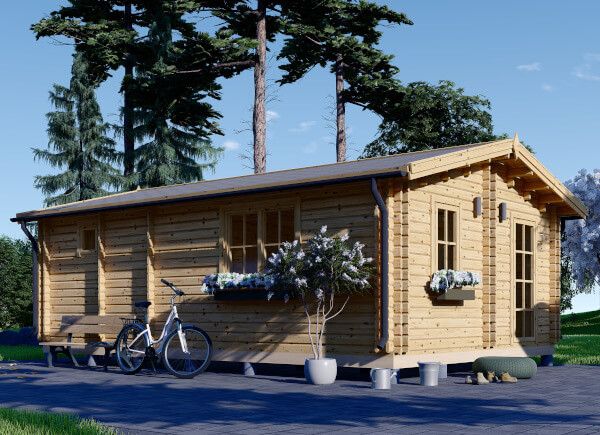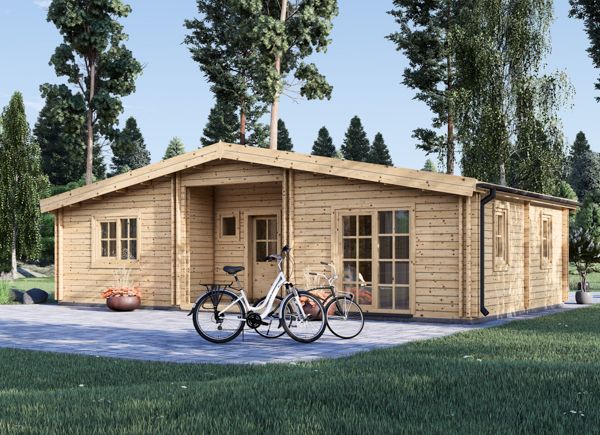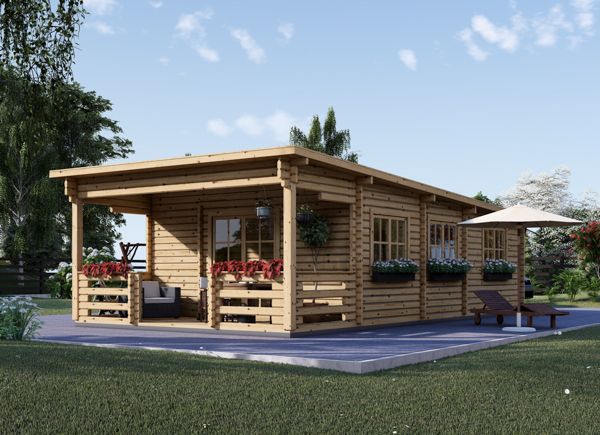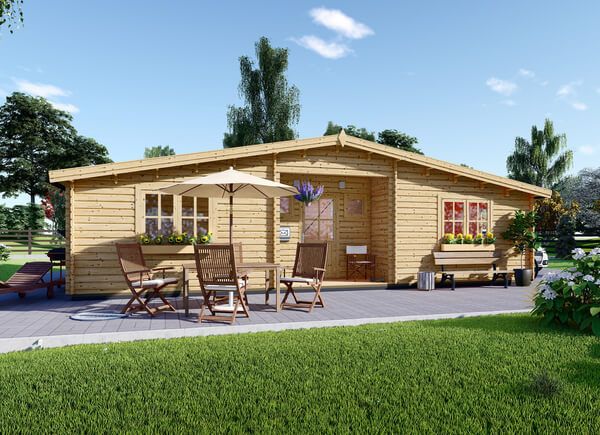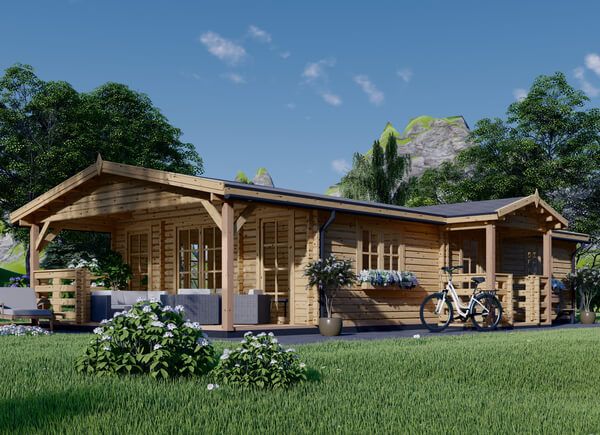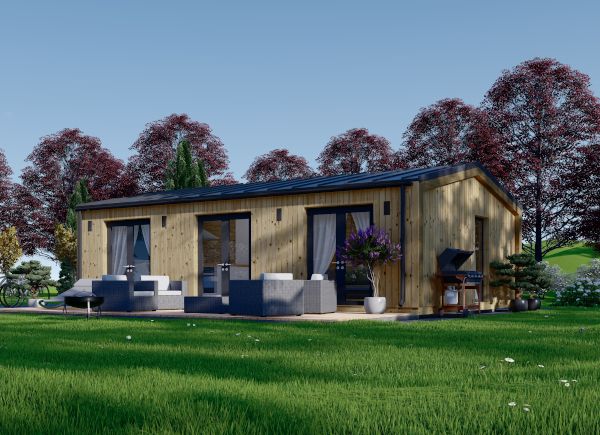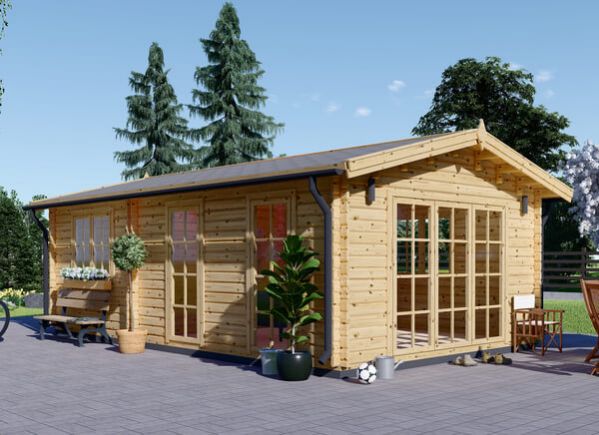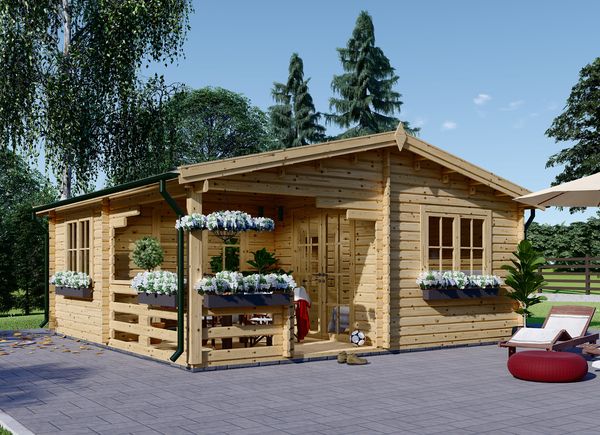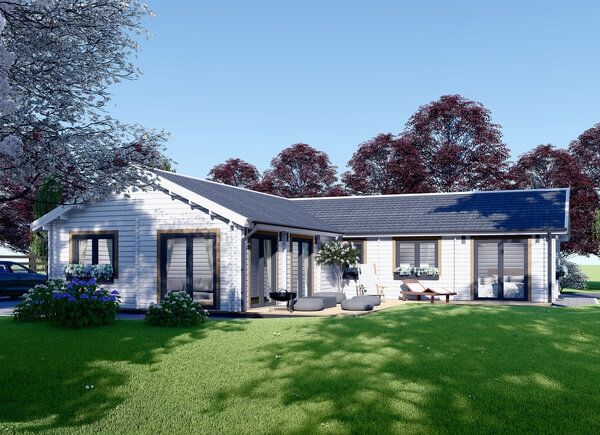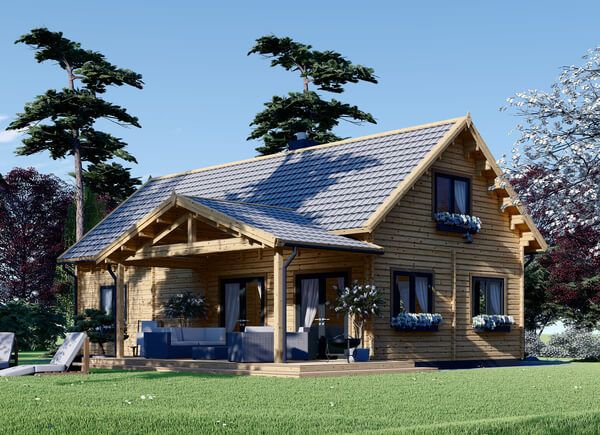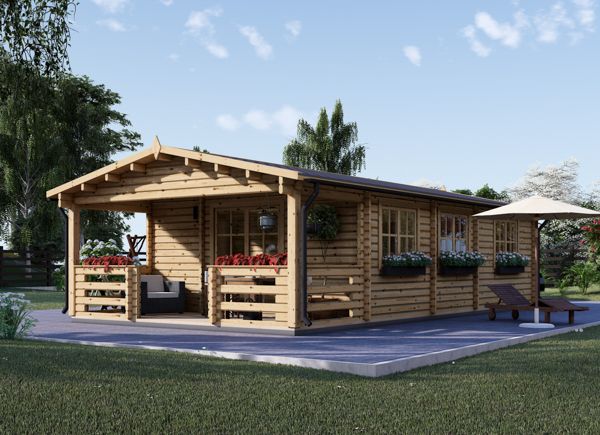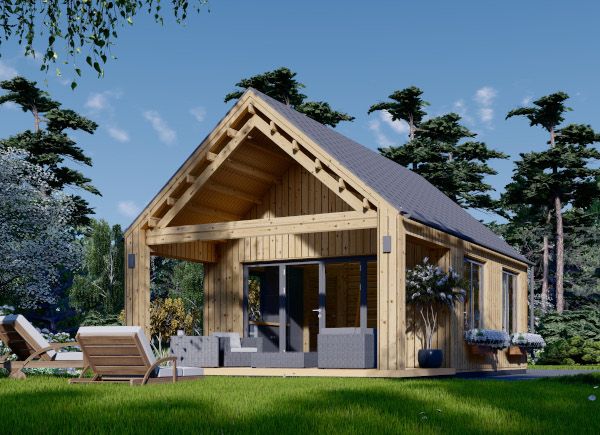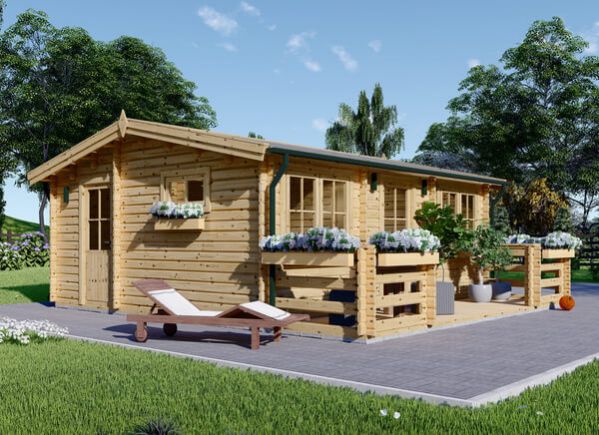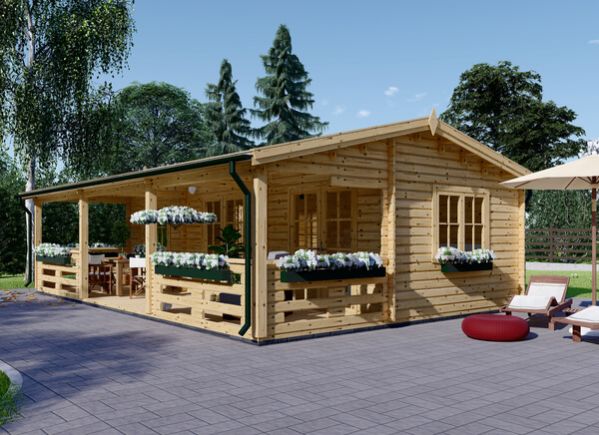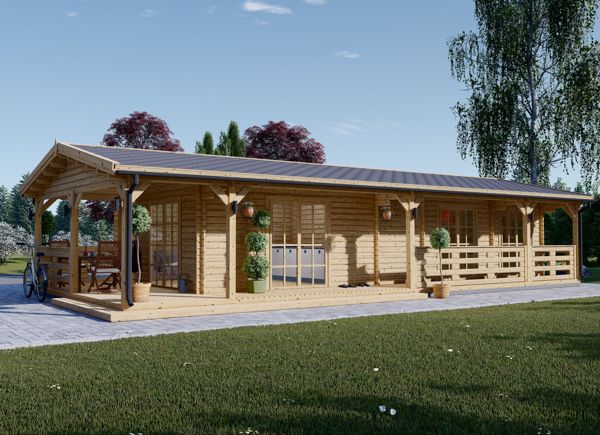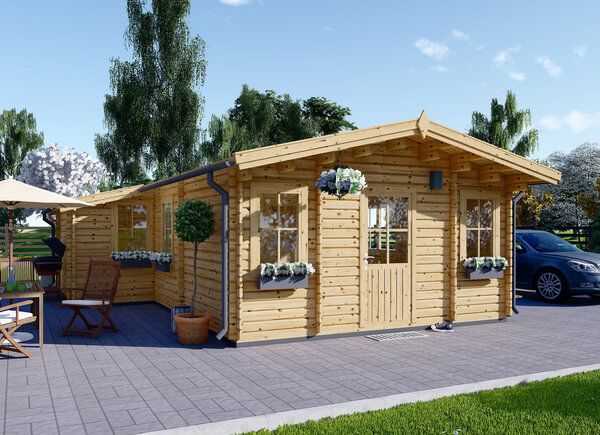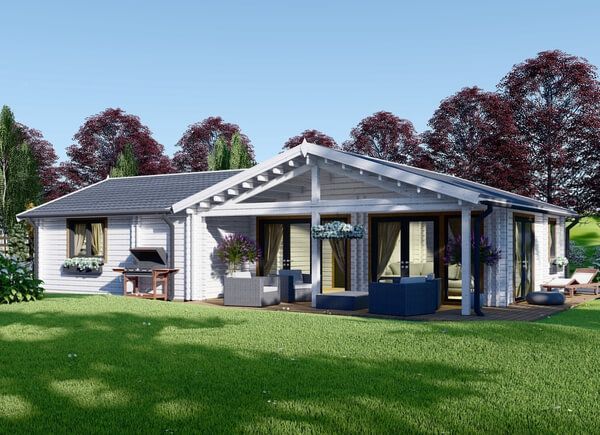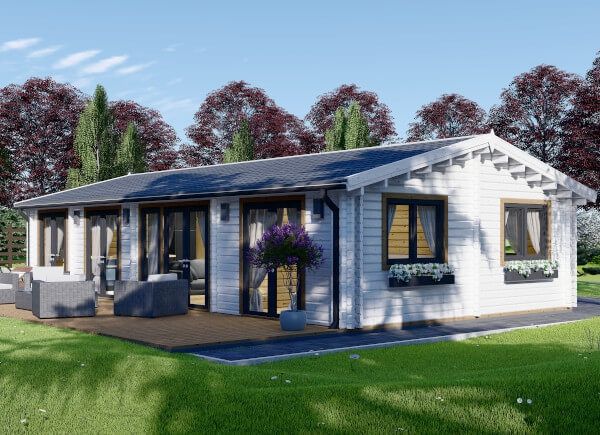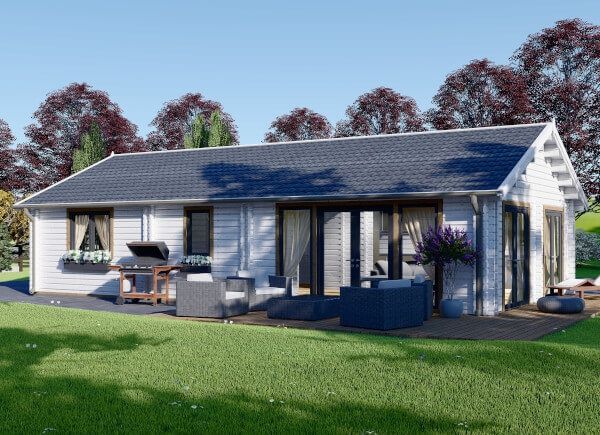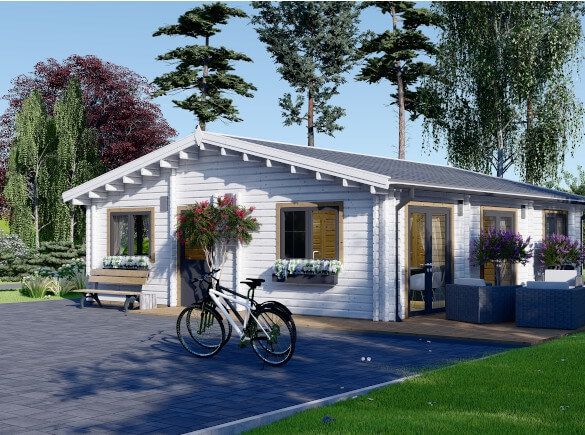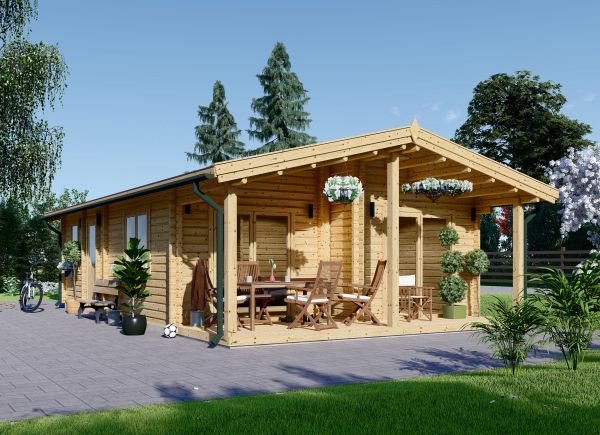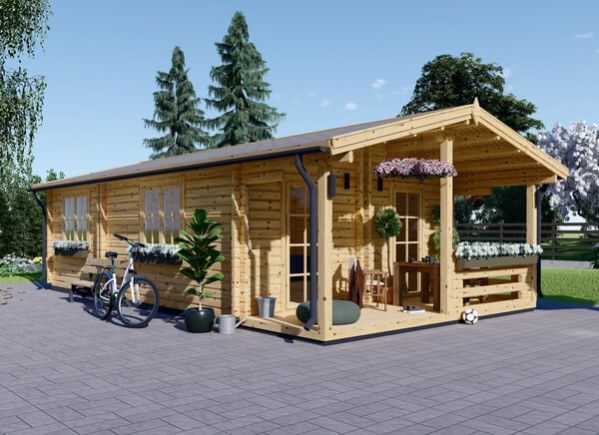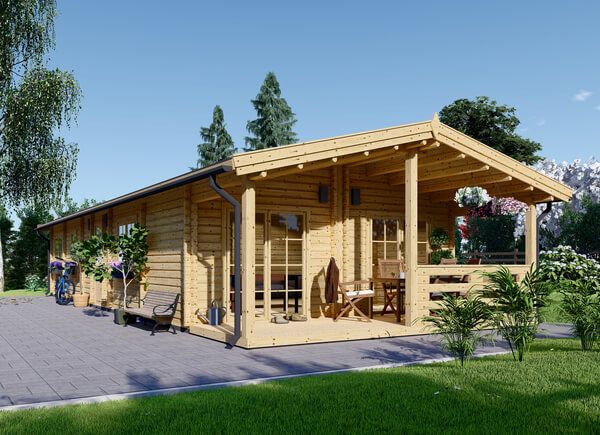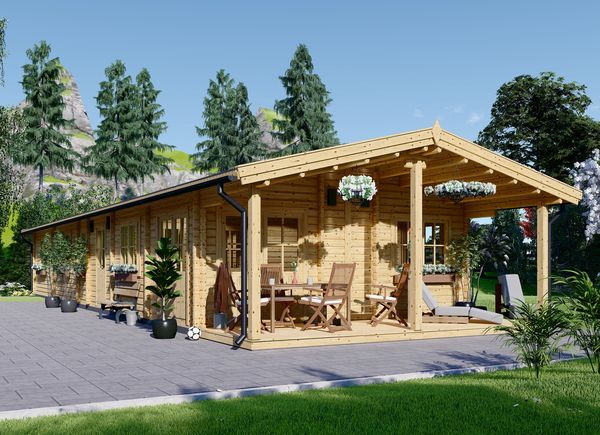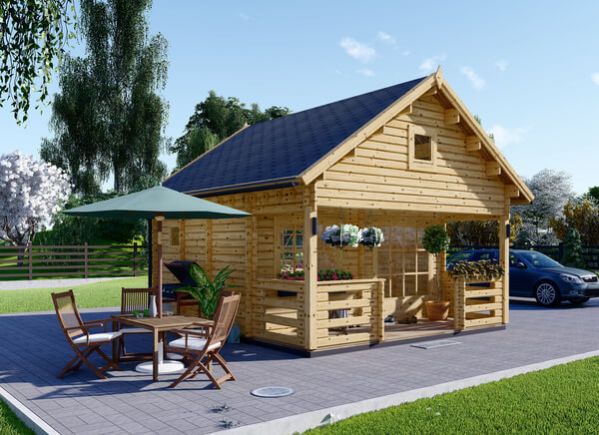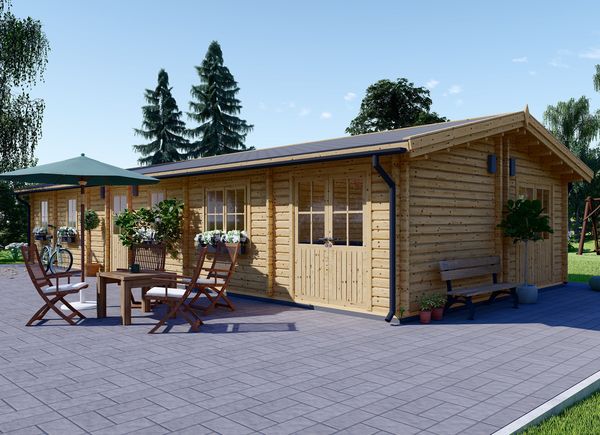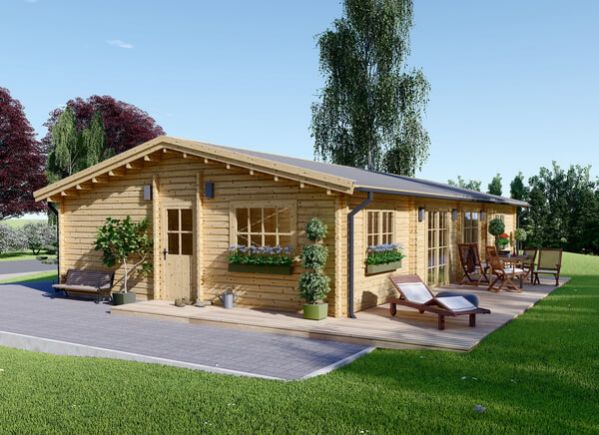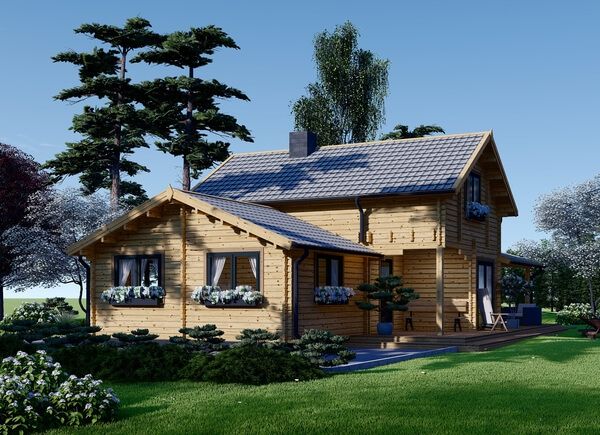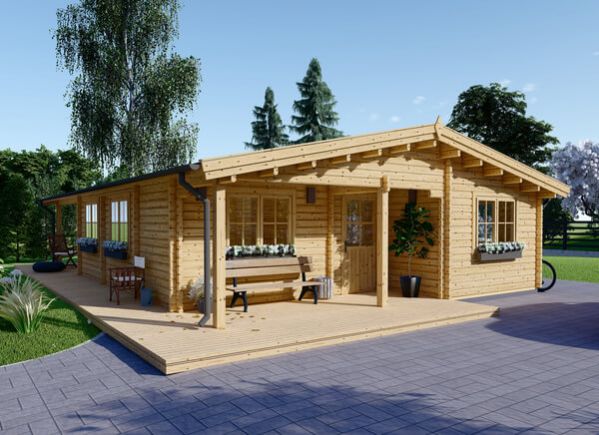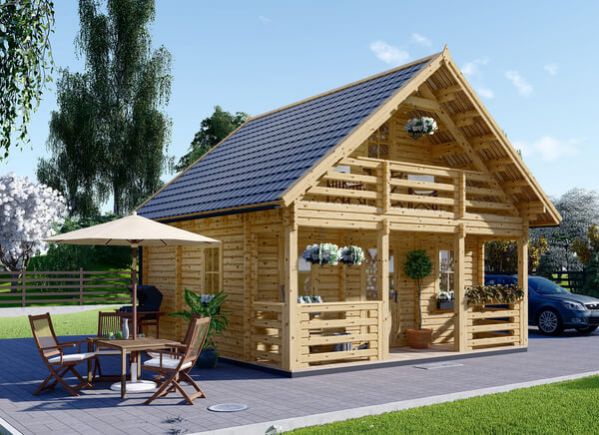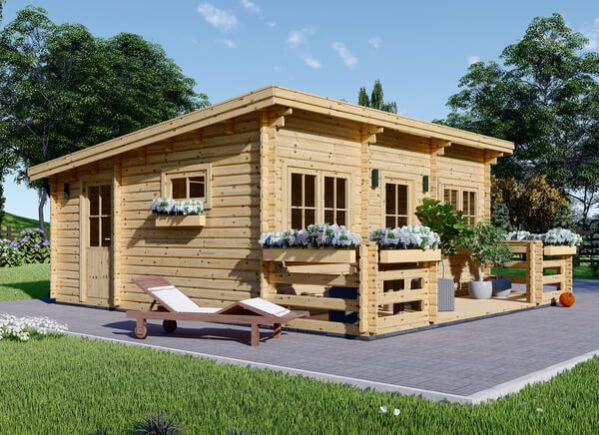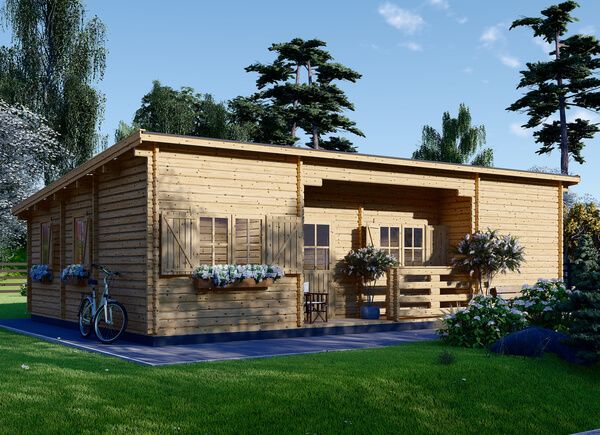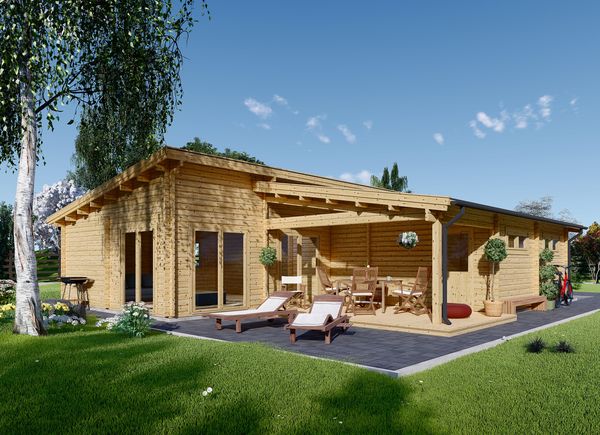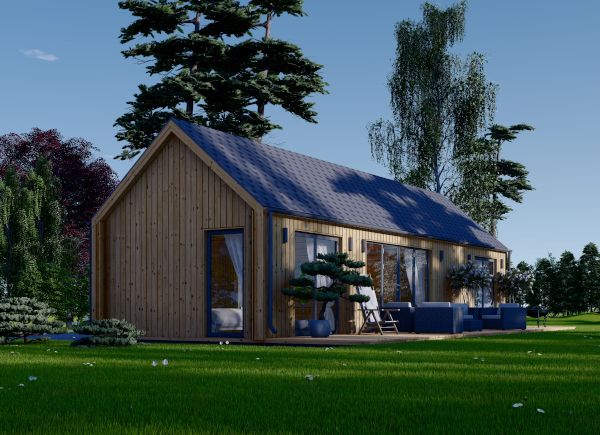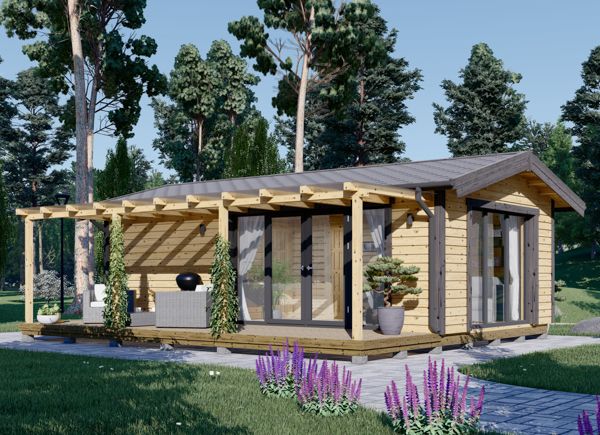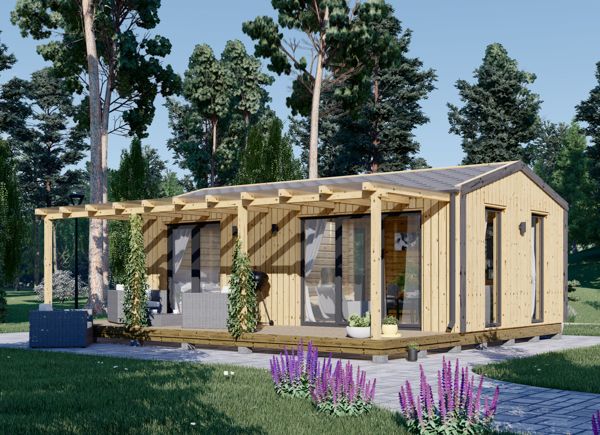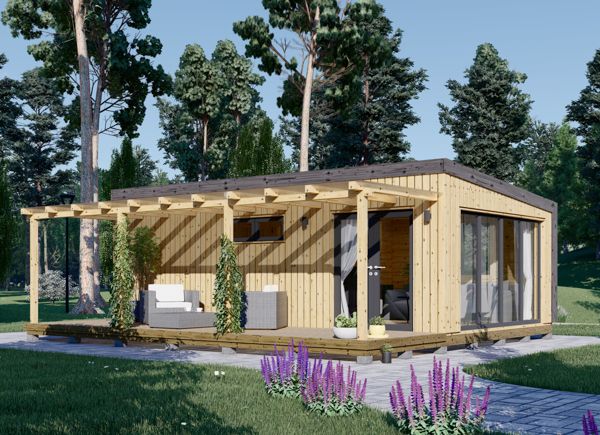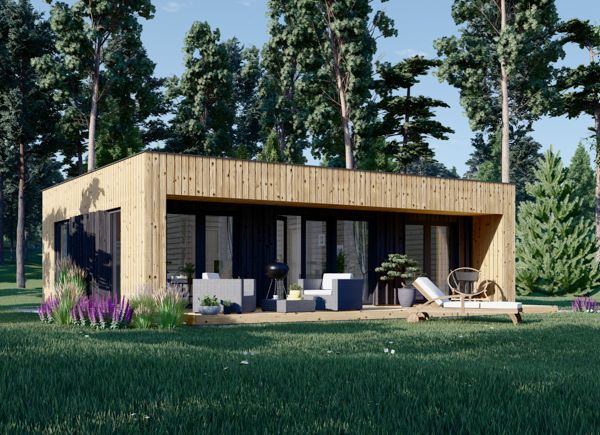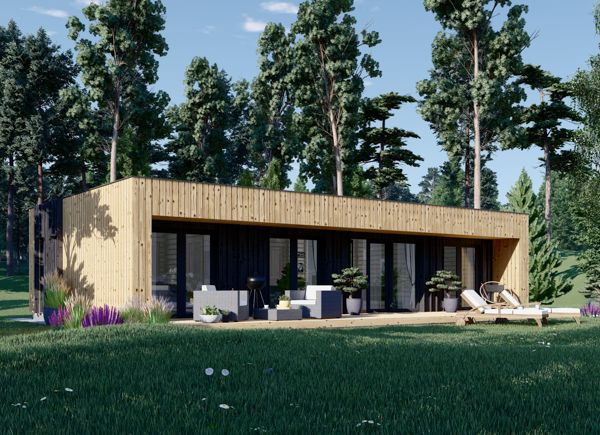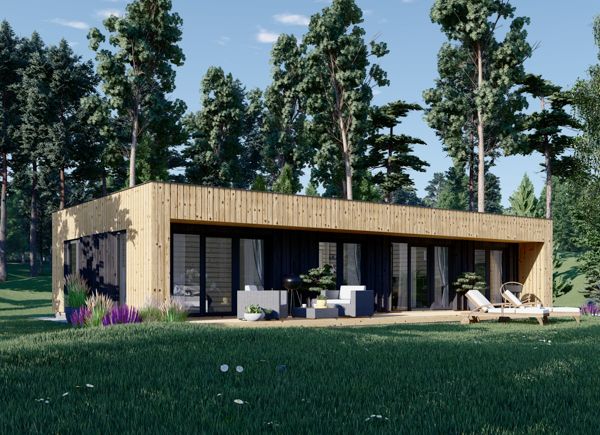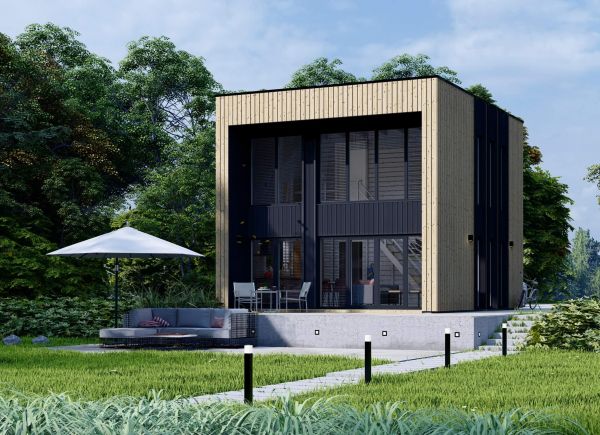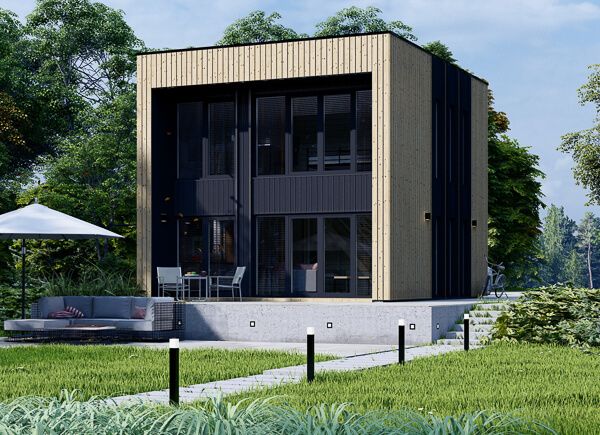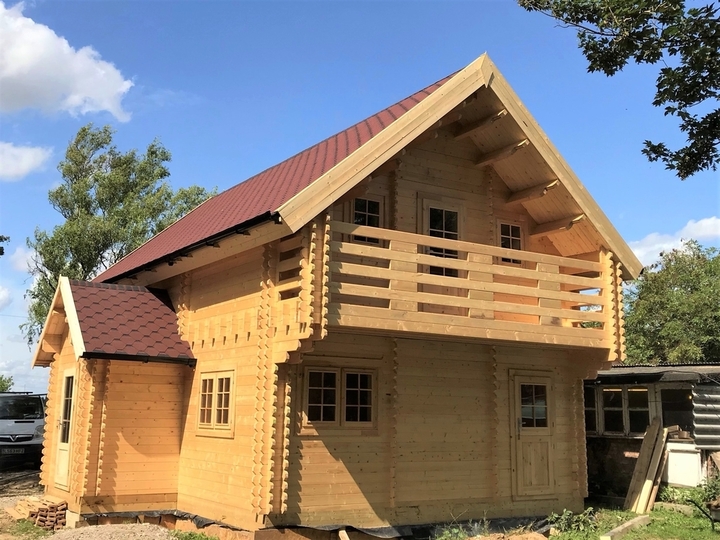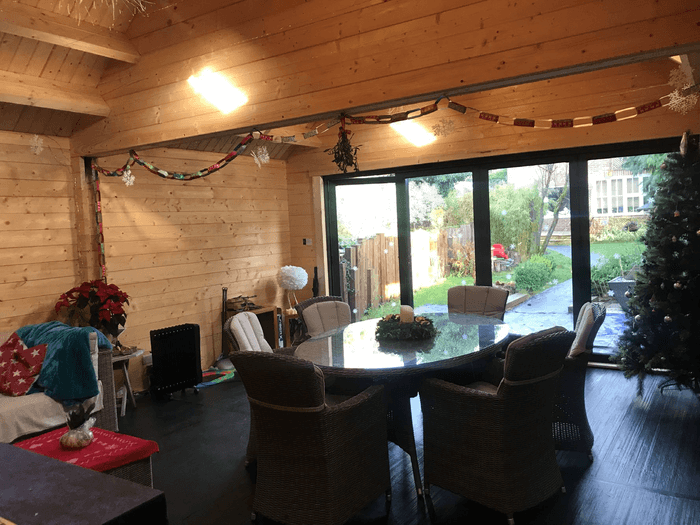Are you sure you want to perform this action?
Residential Log Cabins
Selected
Instant Delivery Available 
Discover classical style granny annexe ARGO M-N and enjoy minimalistic wooden aesthetics. This comfortable and practical model could provide you with a valuable space extension close to your primary residence or serve you as an all-year-round family vacation spot. Due to reliable thermal insulation, ARGO M-N is a lovely model for staying in and enjoying quality time with family and friends during any season of the year.
Important: this mobile cabin home meets all the requirements of the 1968 Caravan Act – therefore, no Planning Permission is usually required if you want to build it within the garden of your existing dwelling to be used as an extra space next to the main house. However, we highly recommend checking with the local planning department before installing it.
- Reliable thermal insulation
- Double-glazed windows and doors
- A perfect residential space extension
Special Price: £31,500.00
- 2 bedrooms
- Spacious & functional layout
- Insulation included in the price
Special Price: £23,299.00

Provide us with details about it. We'll be happy to help!
Write Us A MessageA two-storey wooden house VERA S is highly admired by many customers due to its extraordinary aesthetical appearance and convenient internal layout, allowing each family member or guest to enjoy their privacy. Another lovely highlight of this model is a gorgeous 13.5 m² covered terrace, providing you with the ability to enjoy warm evenings outdoors together with your loved ones. This specific model has white PVC windows and doors, plus white automatic shutters included in the price.
- 3-5 bedrooms
- Spacious 13.5 m² terrace
- White PVC windows and doors included in the price
Special Price: £43,699.00
A compact classic style wooden house ALTURA S features a large living room combined with space for a double bed, a cosy kitchen for relishing delicious meals, and a functional bathroom space. Due to its one-storey layout, ALTURA S is a great choice for families with small children or elderly households. What is more, the clean, simple look will add undeniable charm and grace to your land. Please keep in mind that this specific model has brown (as in, the colour of oak) PVC windows and doors included in its price.
- Residential grade thermal insulation
- Separate dining and bathroom areas
- The price includes brown PVC windows and doors
Special Price: £23,999.00
Wooden house HYMER with a spacious 10 m² covered terrace is an excellent option for those looking for a relaxed family vacation space or a cosy place of residence for experiencing slow-living closer to nature. A beautiful terrace extends the inside area of the house and allows you to enjoy wonderful moments outdoors despite the weather conditions. For your utmost convenience, an insulated version of this model is available as well.
- Version with an apex roof available
- 10 m² covered terrace
- Insulated version available
Special Price: £17,265.00

Provide us with details about it. We'll be happy to help!
Write Us A Message- 2 bedrooms
- Spacious & functional layout
- Insulated version available
Special Price: £14,406.00
- 2 bedrooms
- 11.5 m² covered terrace
- Insulated version available
Special Price: £17,122.00
One of our newest models – a charming insulated one-bedroom granny annexe – provides lots of space to comfortably reside in all-year-long. Whether you are planning to live there yourself or want your loved ones to stay within easy reach, this cabin will work just great for a variety of purposes and applications.
Important: this mobile cabin home meets all the requirements of the 1968 Caravan Act – therefore, no Planning Permission is usually required if you want to build it within the garden of your existing dwelling to be used as an extra space next to the main house. However, we highly recommend checking with the local planning department before installing it.
- One-bedroom cabin
- Insulated throughout
- Contemporary vertical cladding
Special Price: £29,067.00
Compact, welcoming, and cosy wooden house MAX M seems to be specifically created to become your favourite lounging space in the garden, allowing you to admire the beauty you’ve created in your surroundings. It could even transform into a temporary accommodation for your guests or family members visiting for the weekend. If properly insulated, such a house could serve as an independent living space as well. For your utmost convenience, an insulated version of this model is available as well.
Important: this mobile cabin home meets all the requirements of the 1968 Caravan Act – therefore, no Planning Permission is usually required if you want to build it within the garden of your existing dwelling to be used as an extra space next to the main house. However, we highly recommend checking with the local planning department before installing it.
- 3 separate spaces
- Bright and cosy
- Insulated version available
Special Price: £10,438.00
- Compact, functional, and cosy
- 8 m² covered terrace
- Insulated version available
Special Price: £8,331.00
A contemporary style, L-shape log cabin house, featuring 129 m² of the inside area, could be a delightful choice for a larger family for all-year-round living. Enjoy lovely grilling sessions on a gorgeous terrace (optional feature), surrounded by your whole family and friends. For your utmost convenience, an insulated version of this model is available as well.
- 3 comfortable bedrooms
- Large 35 m² terrace (optional feature)
- Insulated version available
Special Price: £51,921.00
A two-storey wooden house VERA is highly admired by many customers due to its extraordinary aesthetical appearance and convenient internal layout, allowing each family member or guest to enjoy their privacy. Another lovely highlight of this model is a gorgeous 13.5 m² covered terrace, providing you with the ability to enjoy warm evenings outdoors together with your loved ones. For your utmost convenience, an insulated version of this model is available as well.
- 3-5 bedrooms
- Spacious 13.5 m² terrace
- Insulated version available
Special Price: £43,552.00
- Available with a flat roof
- 10 m² covered terrace
- Insulated version available
Special Price: £17,042.00
- Thermally insulated
- 2 bedrooms
- 12 m² loft space
Special Price: £18,124.00
Has your house been feeling cramped lately? Building a living space extension in your backyard could save you a lot of hassle when you need some extra room for yourself, visiting friends or a comfortable place of residence for your family members to stay nearby. Wooden house LINCOLN M features a spacious living room area, two mid-size bedrooms, a dedicated bathroom area, and an additional compact space for storage. All you might need from a beautiful traditional style wooden house, and more! For your utmost convenience, an insulated version of this model is available as well.
Important: this mobile cabin home meets all the requirements of the 1968 Caravan Act – therefore, no Planning Permission is usually required if you want to build it within the garden of your existing dwelling to be used as an extra space next to the main house. However, we highly recommend checking with the local planning department before installing it.
- 2 bedrooms
- Spacious and practical
- Insulated version available
Special Price: £28,325.00
- 10 m² loft as a bedroom space
- Stylish roof overhang
- Insulated version available
Special Price: £9,567.00
- Available with a flat roof
- A lovely 9 m² terrace
- Insulated version available
Special Price: £9,071.00
- 13 m² loft as a bedroom space
- Extraordinary 19 m² terrace
- Insulated version available
Special Price: £12,663.00
- 1 bedroom
- 20 m² covered terrace
- Insulated version available
Special Price: £12,251.00
- Thermally insulated
- 2 bedrooms
- Lots of natural light inside
Special Price: £24,035.00
- 2 bedrooms + one spare room
- 23.5 m² living room area
- Insulated version available
Special Price: £18,705.00
- 2 bedrooms
- Gorgeous 29 m² terrace
- Insulated version available
Special Price: £25,802.00
- Three separate rooms
- 18 m² living and dining space
- Insulated version available
Special Price: £11,384.00
- A huge 28 m² living room
- 2 spacious bedrooms
- Insulated version available
Special Price: £36,146.00
- Thermally insulated
- 3 bedrooms
- Lovely 30 m² terrace
Special Price: £30,882.00
A traditional style, two-bedroom wooden house ANICA is a true gem for a small family, a couple or an elder. This house is made of high-quality natural conifer timber, ensuring a healthy living environment and beautiful architectural aesthetics like all our products. For your utmost convenience, an insulated version of this model is available as well.
- 2 bedrooms
- 25 m² living room
- Insulated version available
Special Price: £25,177.00
A lovely wooden house ALICE features almost regular square shape, ensuring an incredibly convenient layout and easy access to all rooms. ALICE has three bedrooms and a spacious living room that will easily fit a kitchen, dining space and a lounging corner with a couch and TV set. Two large double glass doors grant easy access to the backyard or garden. We’ve also included a double door for the street-side main entrance. For your utmost convenience, an insulated version of this model is available as well.
- 3 bedrooms
- 25 m² living room
- Insulated version available
Special Price: £25,420.00
An insulated two-bedroom cabin with a cosy living room could become a perfect place of residence for a family with kids. Also, a great option for elderly grandparents, who love having their grandchildren over and comfortably spending time together, to reside next to the main house.
Important: this mobile cabin home meets all the requirements of the 1968 Caravan Act – therefore, no Planning Permission is usually required if you want to build it within the garden of your existing dwelling to be used as an extra space next to the main house. However, we highly recommend checking with the local planning department before installing it.
- Two-bedroom cabin
- Insulated throughout
- Contemporary vertical cladding
Special Price: £34,980.00
Single-storey mobile house MEGAN M, covering 60 m² of internal space, including a charming, covered terrace, is a compact and cosy wooden solution, providing the required qualities to become one’s comfortable living space. If you want to stay warm and comfortable in this wooden beauty all year round, choosing an insulated version is a must! Conifer timber has natural insulation properties – upgrade it with an additional thermal insulation package and never look back! For your utmost convenience, an insulated version of this model is available as well.
Important: this mobile cabin home meets all the requirements of the 1968 Caravan Act – therefore, no Planning Permission is usually required if you want to build it within the garden of your existing dwelling to be used as an extra space next to the main house. However, we highly recommend checking with the local planning department before installing it.
- Stylish 8m² covered terrace
- 24 m² living room area
- Insulated version available
Special Price: £24,419.00
Discover a classical style wooden house ARGO M and enjoy minimalistic wooden aesthetics in your surroundings. This highly functional, comfortable and practical model could provide you with a valuable living space extension close to your primary residence or, if reliably thermally insulated, could serve you as an all-year-round family vacation spot. For your utmost convenience, an insulated version of this model is available as well.
Important: this mobile cabin home meets all the requirements of the 1968 Caravan Act – therefore, no Planning Permission is usually required if you want to build it within the garden of your existing dwelling to be used as an extra space next to the main house. However, we highly recommend checking with the local planning department before installing it.
- 8 m² terrace for outdoor lounging
- A perfect residential space extension
- Insulated version available
Special Price: £13,861.00
Discover a classical style wooden house ARGO M and enjoy minimalistic wooden aesthetics in your surroundings. This highly functional, comfortable and practical model could provide you with a valuable living space extension close to your primary residence or, if reliably thermally insulated, could serve you as an all-year-round family vacation spot.
Important: this mobile cabin home meets all the requirements of the 1968 Caravan Act – therefore, no Planning Permission is usually required if you want to build it within the garden of your existing dwelling to be used as an extra space next to the main house. However, we highly recommend checking with the local planning department before installing it.
- Thermally insulated
- 8 m² terrace for outdoor lounging
- A perfect residential space extension
Special Price: £26,660.00
Wooden house AVON with 11.5 m² covered terrace offers just the optimal amount of space for a mid-sized or larger family. If you want a spacious and comfortable family house, conveniently divided into numerous smaller spaces, definitely consider this model – it might be precisely the one for you! For your utmost convenience, an insulated version of this model is available as well.
Important: this mobile cabin home meets all the requirements of the 1968 Caravan Act – therefore, no Planning Permission is usually required if you want to build it within the garden of your existing dwelling to be used as an extra space next to the main house. However, we highly recommend checking with the local planning department before installing it.
- 11.5 m² covered terrace
- 2 bedrooms
- Insulated version available
Special Price: £37,142.00
One of our largest wooden house models – granny annexe BOSTON – could be the perfect secondary accommodation for your entire family and friends during cosy weekend stays or fun family celebrations. Due to its functionality and vast interior space, this gorgeous prefabricated building, made of natural conifer timber, have enormous potential of becoming your family’s summerhouse or even a primary living space. Spend valuable time together, surrounded by the best company, nature and fresh air. For your utmost convenience, an insulated version of this model is available as well.
Important: this mobile cabin home meets all the requirements of the 1968 Caravan Act – therefore, no Planning Permission is usually required if you want to build it within the garden of your existing dwelling to be used as an extra space next to the main house. However, we highly recommend checking with the local planning department before installing it.
- Spacious covered terrace
- 30 m² living room
- Insulated version available
Special Price: £44,722.00
- Convenient two-storey structure
- 8 m² covered terrace
- Double glazed windows and doors
Special Price: £10,959.00
Our gorgeous mobile house BRIGHTON is well equipped with 2 or 3 bedrooms (depending on your internal layout arrangement), a living room, a separate kitchen, bathroom space and several additional smaller rooms which could serve you numerous purposes. Due to its vast space and superb internal layout, this house is a perfect base for large family gatherings or get-togethers with friends. For your utmost convenience, an insulated version of this model is available as well.
Important: this mobile cabin home meets all the requirements of the 1968 Caravan Act – therefore, no Planning Permission is usually required if you want to build it within the garden of your existing dwelling to be used as an extra space next to the main house. However, we highly recommend checking with the local planning department before installing it.
- 2-3 spacious bedrooms
- Covenient internal layout
- Insulated version available
Special Price: £37,333.00
- 2 spacious bedrooms
- 2 balconies on the opposite sides
- Insulated version available
Special Price: £34,442.00
- Spacious and cosy
- Two bedrooms
- Insulated version available
Special Price: £34,600.00
Wooden house HOLLAND is an exceptionally functional structure, adored by many customers in the entire country. Its aesthetically pleasing architectural design provides a more contemporary feel than our classical models and is especially valued by modern style admirers. Enjoy the vastness of space, conveniently laid out in two storeys of the building. For your utmost convenience, an insulated version of this model is available as well.
- 3 bedrooms
- Cosy 13 m² terrace
- Insulated version available
Special Price: £44,131.00
Due to its unique layout, charming wooden house LINDA could not be mistaken with any other model. Beautifully designed, this classical-style building provides numerous outdoor lounging spots and a convenient internal layout. Arrange the space based on your individual needs and imagination, making it the most gorgeous and relaxing place, tailored to your specific requirements. For your utmost convenience, an insulated version of this model is available as well.
- 3 bedrooms
- Spacious covered terrace
- Insulated version available
Special Price: £30,321.00
Our two-storey wooden house LIVINGTON, featuring traditional wooden aesthetics and optimal space distribution, could serve you as a functional secondary residence or a cosy summer house. Its spacious covered terrace on the first floor and charming balcony on the second floor provide lots of space for convenient lounging outdoors. Enjoy the stillness, relaxation and experience the feeling of slow-living closer to nature.
- Thermally insulated
- Spacious and comfortable loft
- Compact and cosy
Special Price: £23,802.00
A compact classical style wooden house ALTURA features a large living room combined with a kitchen space, a small bedroom for creating a separate sleeping area and a functional bathroom space. Due to its one-storey layout, ALTURA is a great choice for families with small children or elderly households. What is more, a beautiful 9 m² terrace is perfect for having delicious family meals and spending valuable time together outdoors.
- Thermally insulated
- Available with an apex roof
- A lovely 9 m² terrace
Special Price: £15,093.00
If one would imagine a classical style wooden house featuring plenty of space to comfortably accommodate all the family members and provide enough room to host guests, ensuring everyone’s privacy, it could certainly be our lovely wooden house UZES. Experience the beautiful qualities of natural wood in your surroundings and enjoy life to the fullest in your spacious and cosy wooden residence!
- Thermally insulated
- 2 bedrooms + one spare room
- 23.5 m² living room area
Special Price: £28,947.00
BUILDING REG FRIENDLY
- Residential grade insulation level
- 20 m² terrace and a large balcony
- 2 bedrooms
Special Price: £77,075.00
Have you been dreaming of transferring your life to a new residential space that would instantly feel like home? Our wooden cabin BERTA has all the qualities to become one! Aesthetically pleasing exterior design, cosy and well-designed interior layout, reliable tongue & groove construction, and integrated garage for your exceptional comfort make this house stand out among others. For your utmost convenience, an insulated version of this model is available as well.
- Version with a flat roof available
- Integrated garage building
- Insulated version available
Special Price: £38,547.00
Have you been dreaming of transferring your life to a new residential space that would instantly feel like home? Our wooden cabin BERTA has all the qualities to become one! Aesthetically pleasing exterior design, cosy and well-designed interior layout, reliable tongue & groove construction, and integrated garage for your exceptional comfort make this house stand out among others. For your utmost convenience, an insulated version of this model is available as well.
- Available with an apex roof
- Integrated garage building
- Insulated version available
Special Price: £40,238.00
The charming wooden house DARLA is a two-storey building that offers 5 bedrooms, 3 bathrooms, a practical layout, and a covered entrance – and that's just the beginning. This model also features a large living room and kitchen area, and the bedrooms can be found on both floors, which is ideal for bigger families that want to have some private space. DARLA also features plenty of windows, making all the rooms bright and airy. For your utmost convenience, an insulated version of this model is available as well.
- 5 bedrooms
- 30 m² covered terrace
- Insulated version available
Special Price: £62,242.00
The bright and spacious wooden house ADALINE attracts the eyes of many due to its sleek contemporary architectural design. Its beauty lies in the wonderful forms and modern cladding solutions as well as large windows, letting all the beautiful sunshine in and brightening up your space. A delightful 24 m² terrace provides you with the freedom to enjoy quality time outdoors.
- 2 bedrooms
- 24 m² terrace
- Efficient thermal insulation
Special Price: £19,168.00
- Horizontal timber cladding
- 1 bedroom & a spacious living room
- Efficient thermal insulation
£19,251.00
- Available with a flat roof
- 1 bedroom & a spacious living room
- Efficient thermal insulation
£17,635.00
- Available with a flat roof
- 1 bedroom & a spacious living room
- Efficient thermal insulation
£18,059.00
- 1 bedroom, 1 bathroom
- 20 m² terrace (as an extra option)
- Insulated version available
Special Price: £22,409.00
- 2 bedrooms, 2 bathrooms
- 28 m² terrace (as an extra option)
- Insulated version available
Special Price: £27,562.00
- 3 bedrooms, 1 bathroom
- 31 m² terrace (as an extra option)
- Insulated version available
Special Price: £30,053.00
The ultimate representation of modern architecture, KAYA 4L is a striking structure that will leave an impression on anyone who lays eyes on it. The layout of this model is very family-friendly, as there's a huge 20 m² living room, 2 bathrooms, and a bedroom upstairs. You'll also find a room that can be converted into a workspace or an additional bedroom. The large windows will help you enjoy sunny days inside, and stepping out on the covered terrace may also turn into a small delight. For your utmost convenience, an insulated version of this model is available as well.
- 1 bedroom, 2 bathrooms
- A cosy terrace with an option to extend it
- Insulated version available
Special Price: £32,454.00
The ultimate representation of modern architecture, KAYA 4 is a striking structure that will leave an impression on anyone who lays eyes on it. The layout of this model is very family-friendly, as there's a huge 20 m² living room, 3 bathrooms, and 2 bedrooms upstairs. You'll also find a room that can be converted into a workspace or an additional bedroom. The large windows will help you enjoy sunny days inside, and stepping out on the covered terrace may also turn into a small delight. For your utmost convenience, an insulated version of this model is available as well.
- 2 bedrooms, 3 bathrooms
- A cosy terrace with an option to extend it
- Insulated version available
Special Price: £35,932.00

Provide us with details about it. We'll be happy to help!
Write Us A Message




 Log Cabins
Log Cabins

